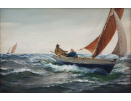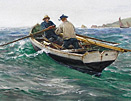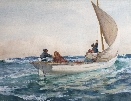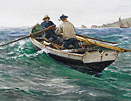Charles Napier Hemy (1841-1917)
Charles Napier Hemy was a British painter best known for his marine paintings and his two paintings in the Tate collections. He was born to a musical family at Newcastle-Upon-Tyne and his two brothers, Thomas and Bernard, were also painters, though Thomas is said to be the most artistically distinguished of the three. The Hemy family are known to have briefly emigrated to Australia, returning to England in the middle of the 1850s, Thomas Hemy helping to man the ship on the return journey. On arriving back to Northumberland, Hemy decided to enter the priesthood, but his love of the sea soon led him to give up this intention. He became an apprentice on a collier brig and followed this life quite happily until aged 19, when he again decided to enter the priesthood, entering a monastery on Newcastle where he learned to draw and paint. At the end of this period he resolved to become a professional artist. He trained in the Government School of Design, Newcastle, under William Bell Scott, followed by the Antwerp Academy and the studio of Baron Leys. He returned to London in the 1870s and in 1881 moved to Falmouth in Cornwall. He painted figure and landscapes, but is best known for his marine works and spent almost as much time afloat as ashore in his studio, an adapted boat. The Vandervelde, which, like its successor the Vandermeer, was named after a great Dutch painter, sank in a winter storm but with an affectionate sentiment Hemy recovered and made part of the wreck into a studio/summer-house in the garden of his villa, Churchfield. Elected an Associate of the Royal Academy in 1898 and an Academician in 1910, he was also honoured as an Associate of the Royal Society of Painters in Water Colours in 1890 and became a member in 1897. His paintings are signed 'C N Hemy' or 'C N H'.
Paintings for sale by Charles Napier Hemy:
Click on a thumbnail to see a larger image and more information.



